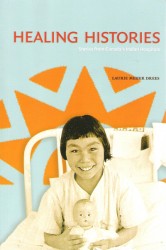Article Origin
Volume
Issue
Year
Healing Histories: Stories from Canada’s Indian Hospitals
Laurie Meijer Drees
University of Alberta Press, 2013
Edmonton, Alberta
ISBN 978-0-88864-650-7
244 pages
Reviewed by Heather Andrews Miller
In the early twentieth century, infectious diseases ravaged the populations of Canada, especially in the north. The occurrence of tuberculosis and measles reached epidemic proportions and whole families and often whole communities were devastated.
Laurie Meijer Drees describes the government’s practice of the day to heal those affected Indigenous people by sending them to hospitals in southern Canada, under threat of action by the law if they refused to go. Thus began another institutional experience for Aboriginal people in our country which, when paired with the residential school system, made a vast impact on the living culture of First Nations, Dene, Métis and Inuit people.
Drees, who is co-chair of the First Nations Studies Department at Vancouver Island University, states in her book that 18 hospitals offered treatment including Edmonton, Nanaimo, and Fort Qu’Appelle. The Charles Camsell Indian Hospital in Edmonton was considered one of the best. With 350 beds that later grew to number 500, the Camsell was a former Jesuit College refurbished by the American military during World War Two. However, unlike the hated Indian Residential School, the occupants at the Camsell were encouraged to pursue the making of traditional handicrafts, which were offered for sale in the hospital’s gift shop. Those who were not bedridden were invited to play outside the facility and many overcame their homesickness by developing close friendships with other patients. For the older patients, movies, dances, visiting entertainers and music were provided to help pass the long hours of prescribed bed rest. TB, as tuberculosis is commonly known, can occur in people of any age, and there was a mixed population of children and adults who tried to help each other back to a healthy life and a return to their home communities.
As Drees explains, infection rates for Aboriginal people were 10 times the national average in 1944. The disease was unknown to the population until the European settlers introduced it in the 1700s. With the building of the railway and the establishment of the reserve system, First Nations people were confined in crowded living conditions and were often under-nourished, further facilitating the spread of the disease. Many more developed the condition in residential schools where death rates were high.
In addition to government statistics and commentaries by non-Aboriginal officials and health practitioners, also included are compelling revelations of former patients who benefitted from their stays at the hospitals. Some went on to careers as registered nurses and health care workers, inspired by their desire to improve their communities back home. Indeed, Drees credits these early professionals with spawning the seeds for self-determination in Aboriginal health care. Others stayed to work in the laundry, housekeeping or kitchen areas, making the most of their recuperation by participating in the hospital’s educational and occupational programming.
The patients were usually from small isolated communities and they saw for the first time the bright lights of the city and experienced modern household conveniences. It was often a time of realization about a new world of which they knew nothing.
The intercultural book will be of value by those interested in the history of medicine and nursing, and of Canadian Aboriginal people. Oral histories have been captured to become part of the experience of a diverse group of individuals who were affected by tuberculosis in the middle of the 20th century in Canada and who shared an awakening during their healing. It moves beyond the colonialism, victimization, and cultural destruction of other experiences and leaves the reader well-informed about a period of Canada’s history which changed lives forever.
- 1737 views

